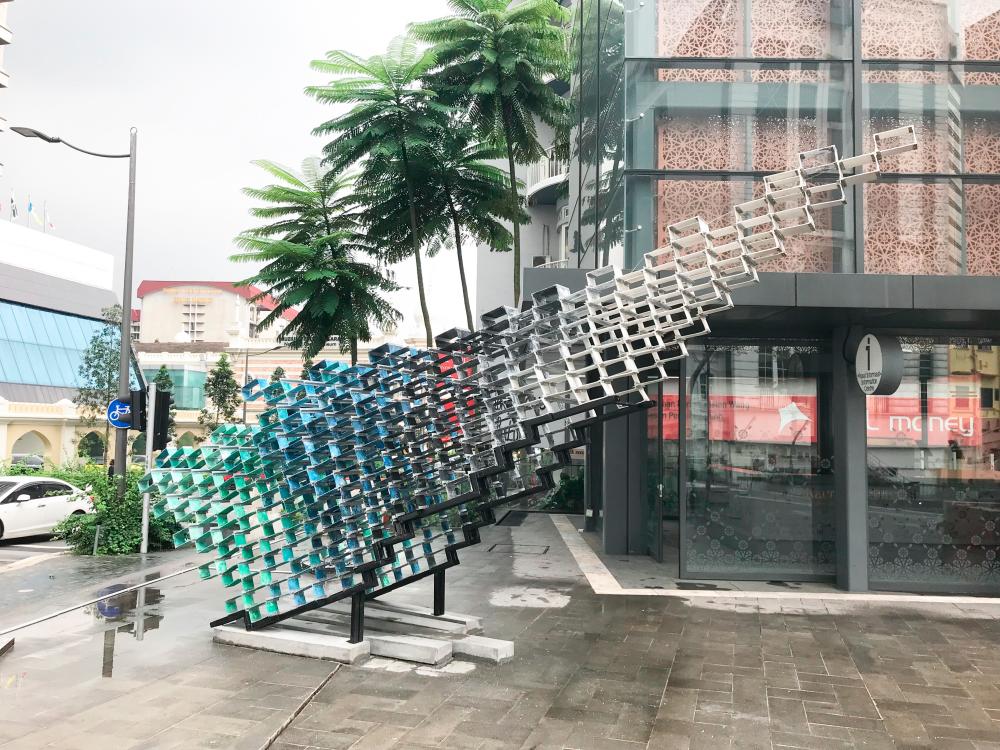TRAINED as an interior designer, Joshua Teo completed his degree with a minor in linguistics from Taiwan’s Chung Yuan Christian University in 2018, and also has experience across other disciplines such as architecture, music and debating.
Over the years, the 25-year-old lad from Kuching, Sarawak has bagged numerous international accolades for his work. I was lucky to have been able to meet the designer himself on a balmy evening at a curated art walking tour designed to bridge art and people, organised by The Art Seni in conjunction with Art In The City and Urbanscapes across multiple city spots.
Entwine, Teo’s site-specific art installation made entirely out of recycled plastic tiles, is located at the Masjid Jamek Lookout Point.
It serves as an open letter to both the authorities and to the public, addressing the city’s waste management predicament.
Entwine exposes the palpable power dynamic that defines the contemporary cityscape in the face of an environmental crisis, through a juxtaposition of its representational topography of two rivers in the abstract sense, and the materials that form it – plastic.
What spurred your interest in interior design?
“I’m not [merely] interested in interior design, but design in its entirety. A friend told me [once], that design is the art of problem-solving, and that has become my motto, I guess. Through creative and artistic methods, we can find new solutions to problems – that’s how I became interested in designing.”
How did you become a sculptor?s
“Spatial designers such as interior designers, architects and landscape architects are trained to create or enhance the built environment, and I think that skill is important in constructing an art installation.
“I don’t see myself as a sculptural artist per se, but being equipped with my interior design background, I felt confident enough to apply for [Art In The City]. That was how I started off creating a sculpture in the first place: some spatial design knowledge, and a little courage.”
As a trained interior designer, how did you approach Entwine?
“I usually find my inspiration from site-specific issues. For Entwine particularly, I realised that Kuala Lumpur is often plagued with flash floods, which is exacerbated by the city’s lack of efficient waste management, which in turn inspired me to create a piece made of reused materials.
“During the monsoon season, when we started constructing the piece, the river rose dangerously close to the level of Masjid Jamek, which was quite alarming. This experience, to me, reassured the relevance of [Entwine].”
Share with us the rationale behind Entwine.
“Inspired by the confluence of the Klang and Gombak rivers, Entwine is a sculpture of two masses merging into one. Driven by my fascination with algorithmic thinking and all things cutting edge, I tried to convey my narrative using parametric design in response to the environmental concerns of the [city].
“Incorporating the use of a form of sustainable material that I’ve seen fellow designers use previously in their creations, I created an abstract sculptural form consisting of a calibrated series of interlocking recycled plastic hollow blocks, in reverence of the confluence.”
What other campaigns touched upon plastic pollution?
“During the Art In The City period, we held two separate outreach programmes. The Sea Monkey Workshop, stationed in Subang and across several islands in Malaysia, was our main facilitator for these events.
“The first programme was an open workshop, where the public could participate in learning how to use machines to make recycled plastic necklaces. These are the same [machines] used to create the hollow blocks for my installation.
“The second event was a collaboration among several professional designers and students to create artworks or products using these machines. These works were exhibited sporadically throughout the campaign period. The outcome was a more academic take on using the machines to create new ideas using recycled plastic.”
How will the recycled plastic tiles be treated or disposed of afterwards?
“I hope the installation can be displayed somewhere else as a permanent art piece. Otherwise, I’ve already come up with several ideas that were included in the proposal for Entwine as to how the plastic modules can be reused.
“Some of the more interesting ideas include reusing the plastic blocks to make a façade, a mural or even a playground set.”
How different is the creative and artistic landscape in Kuala Lumpur compared to Kuching?
“Kuching’s creative landscape focuses a lot on the Bornean nature, culture, heritage and identity. It celebrates individual expression openly and of that, I’m immensely proud. In fact, Sarawak houses the most creative festivals in Malaysia.
“Kuala Lumpur’s creative landscape, on the other hand, is more diverse and dynamic, ranging from the performing arts, to street art, to architecture. And obviously being the country’s capital and economic centre, the city offers more opportunities for young artists.”
What is your next project?
“Entwine was my first ever public project, and it was commissioned in the Peninsula. My goal is to work on the Bornean context next.
“Currently, I have plans to make a kinetic installation, so do watch out for that.”









